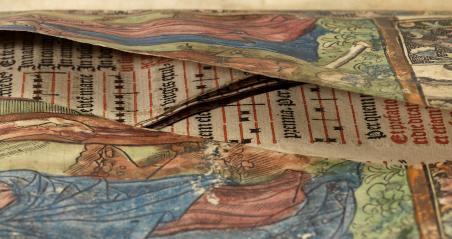
Contributors to Remembering the Reformation
This exhibition is a testament to the fruitfulness of collaborative work—not only among the members of our research team, but between our project and a number of research institutions and their staff.
The physician Andreas Vesalius was born 500 years ago in 1514; he died fifty years later, in 1564. He is best known for his Seven books on the fabric of the human body (commonly known as the Fabrica after its Latin title) published in 1543. It was a landmark publication in the history of medicine, with its large format, numerous woodcuts and detailed description of the structures and functions of the human body. Even larger, though much shorter, was a companion piece called the Epitome of the seven books on the fabric of the human body, published in the same year. Cambridge University Library has a rich collection of sixteenth-century medical books, including four copies of the first edition, two copies of the second edition of the Fabrica, and a unique, coloured copy of the Epitome.
These books were innovative in form and in content. In form, they were designed with features such as dissected bodies in various gestures, tailor-made initials, continuous background landscapes, and layered paper bodies. In content, they sought to revive first-hand knowledge of anatomy as the foundation of medicine, as practised by the ancients and advocated by Galen (a Greek physician working in Rome in the second century AD). ‘Vivitur ingenio, caeteris mortis erunt’ is a phrase (attributed in the sixteenth century to Virgil) Vesalius attached to one of the images in his Fabrica. ‘Ingenium’ was a word that meant natural inclination, innate capacity, talent or wit, and when contrasted with death, it could suggest something like spirit. The phrase may thus be translated as ‘one lives on by the spirit, the rest shall belong to death’. This exhibition highlights the ‘Vesalian spirit’ by focusing on some of the striking features of Vesalius’s work within the context of other illustrated medical books of the period in the Cambridge collection.
Nowhere is the Vesalian spirit better captured than in the frontispiece of the Fabrica, which has an iconic status in the history of medicine. Click here to watch Dr Andrew Cunningham, author of The anatomical Renaissance: the resurrection of the anatomical projects of the ancients (1997), discuss the man and his book.
Visit the exhibition themes by clicking on the square thumbnails in the row below. Full images of the exhibits can be viewed by clicking on the large square thumbnails at the foot of each theme page. The Cambridge coloured copy of the Epitome can be viewed in full in the Cambridge University Digital Library.